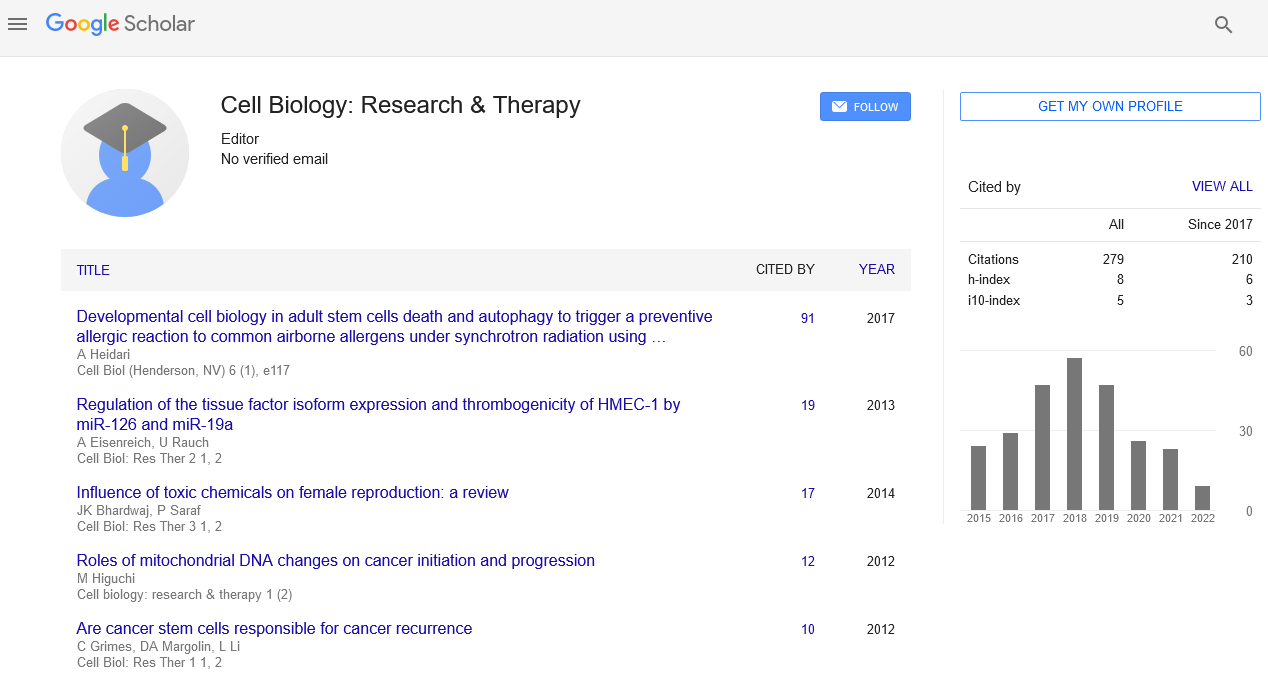Perspective, Cell Biol Vol: 12 Issue: 2
An Overview on Major Histocompatibility (MHC): Its Structure, Functions and Implications
Yuan Yao*
1Department of Immunology, Zhongshan University, Guangzhou, China
*Corresponding Author: Yuan Yao,
Department of Immunology, Zhongshan
University, Guangzhou, China
E-mail: yuan@yao.cn
Received date: 22 May, 2023, Manuscript No. CBRT-23-105056;
Editor assigned date: 24 May, 2023, PreQC No. CBRT-23-105056 (PQ);
Reviewed date: 07 June, 2023, QC No. CBRT-23-105056;
Revised date: 14 June, 2023, Manuscript No. CBRT-23-105056 (R);
Published date: 21 June, 2023 DOI: 10.4172/2324-9293.1000183
Citation: Lei F (2023) An Overview on Major Histocompatibility (MHC): Its Structure, Functions and Implications. Cell Biol 12:2.
Description
The Major Histocompatibility Complex (MHC) is a highly diverse and essential part of the immune system in vertebrates. Also known as the Human Leukocyte Antigen (HLA) complex in humans, MHC molecules play a crucial role in presenting antigens to T cells, regulating immune responses, and facilitating tissue compatibility. In this study one will delve into the intricacies of the MHC, exploring its structure, functions, and implications beyond immune responses.
Structure and classes of MHC molecules
MHC molecules are transmembrane proteins that are classified into two main classes: MHC class I and MHC class II. MHC class I molecules are found on the surface of almost all nucleated cells and present antigens derived from intracellular pathogens to cytotoxic T cells. MHC class II molecules are primarily expressed on antigenpresenting cells, such as dendritic cells, macrophages, and B cells, and present antigens to helper T cells.
Antigen presentation and T Cell activation
One of the primary functions of MHC molecules is to present antigens to T cells, which is critical for initiating and coordinating adaptive immune responses. MHC class I molecules present endogenous antigens to CD8+ cytotoxic T cells, while MHC class II molecules present exogenous antigens to CD4+ helper T cells. This antigen presentation process activates T cells, leading to the proliferation and differentiation of effector T cells to eliminate the specific antigen.
MHC diversity and immune recognition
The MHC is highly polymorphic, meaning that there are numerous variants (alleles) of MHC genes within a population. This diversity allows MHC molecules to present a wide range of antigens, enabling the immune system to recognize and respond to a vast array of pathogens. The recognition of specific antigens by T cells is highly dependent on the interaction between MHC molecules and T cell receptors, ensuring the specificity and effectiveness of immune responses.
MHC and tissue compatibility
The MHC also plays a crucial role in determining tissue compatibility for transplantation. The compatibility of MHC molecules between the donor and recipient is crucial for successful organ or tissue transplantation. Mismatched MHC molecules can trigger immune responses, leading to graft rejection. Matching MHC profiles between donors and recipients is a key consideration in transplantation medicine.
MHC and disease associations
The genetic diversity of MHC molecules is also associated with susceptibility to various diseases. Certain MHC alleles are linked to increased or decreased risk of developing certain autoimmune diseases, infectious diseases, and even some cancers. The specific MHC alleles inherited by an individual can influence their susceptibility to certain diseases and shape the immune response to infection or tumor antigens.
Role of MHC in vaccines and therapeutics
Understanding the MHC diversity and antigen presentation processes is crucial for vaccine development and immunotherapy. Vaccines aim to elicit specific immune responses by presenting antigens to T cells through MHC molecules. In immunotherapy, strategies are being developed to manipulate MHC presentation to enhance immune responses against cancer cells or modulate autoimmune responses.
MHC in evolution and beyond immune responses
The MHC is an ancient and highly conserved genetic region that has implications beyond immune responses. Studies suggest that MHC genes may play a role in mate selection and reproductive success, as individuals with diverse MHC profiles may confer greater resistance to pathogens in their offspring. Additionally, MHC molecules may have functions in embryonic development, neurobiology, and tissue homeostasis, extending their influence beyond the immune system.
Conclusion
The Major Histocompatibility Complex (MHC) is a vital component of the immune system, governing immune recognition, antigen presentation, and tissue compatibility. Its diverse and polymorphic nature allows for the recognition of a wide range of antigens and plays a critical role in adaptive immune responses. Beyond immune functions, the MHC is associated with disease susceptibility and has implications in transplantation, vaccine development, and even evolutionary biology.
Advancements in understanding the MHC and its interactions with T cells have paved the way for innovative approaches in immunotherapy and personalized medicine. Manipulating MHC presentation holds promise for enhancing immune responses against cancer, infectious diseases, and autoimmune disorders. Furthermore, continued research on the MHC may uncover its roles in non-immune processes, contributing to our understanding of development, reproduction, and tissue homeostasis.
 Spanish
Spanish  Chinese
Chinese  Russian
Russian  German
German  French
French  Japanese
Japanese  Portuguese
Portuguese  Hindi
Hindi 